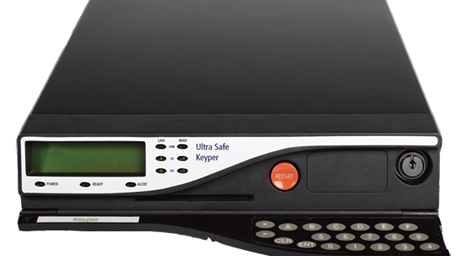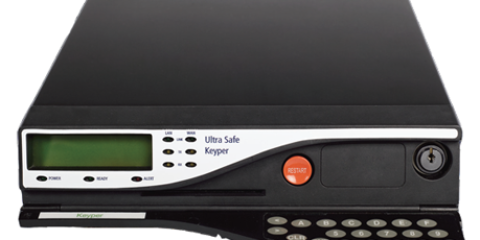
The Keyper Load Balancer is a highly flexible piece of software that sits between the Keyper Hardware Security Module (HSM) and its Providers (PKCS#11, Microsoft CAPI/CNG Providers)
The Keyper Load Balancer is a highly flexible piece of software that sits between the Keyper Hardware Security Module (HSM) and its Providers (PKCS#11, Microsoft CAPI/CNG Providers). It allows:
Scalability – Aggregated performance of multiple HSMs acting in parallel
Resilience – Active-active high availability HSM configurations
Automatic Key Backup – key replication over a secured channel
Geographic DR – Architectures supporting service continuity
All of these services are transparent to the Application and the Provider, without either being ‘aware’ that any of these services are being performed. Up to 16 Keypers can be handled, appearing as one logical Keyper to the application accessing those Keypers via an AEP Provider.
The Keyper Load Balancer itself can be installed on the same host as the application and Provider or can be installed on dedicated hosts.
Keyper Load Balancer supports a wide variety of architectures, including:
- Load Balancer on Application Server(s)
- Load Balancer per Application Server(s)
- Dedicated Load Balancer server(s)
- Application Servers clustered with Load Balancer server(s)
- Geographically distributed Disaster Recovery Load Balancer server(s)
Key business benefits
- Assurance against loss of cryptographic keys
- Future proofed scalability without initial over specification. HSMs deployed as required will scale to the demand of the highest-performance applications
- Automated fault tolerant service continuity
- Allows for flexibility of Load Balancer placement within the system architecture
- Graceful handling of loads that could otherwise exceed an HSM’s capacity
- Enables project to select OS to suit application
- Centralised source for audit across HSM estate, configurable to four levels of detail and three categorisations of events
- Session open, request timeouts and retry timers can be configured to match application requirements for optimal performance across widest range of architectures
- Service continuity in case of unexpected Load Balancer process termination
- Automatic key distribution amongst load balanced Keypers: Assurance against loss of cryptographic keys
- Aggregated performance of multiple HSMs, added on demand: Future proofed scalability without initial over specification. HSMs deployed as required will scale to the demand of the highest-performance applications
- Active-active High Availability HSM Architectures, with HSM failure handling: Automated fault tolerant service continuity
- Standards based TCP/IP application: Allows for flexibility of Load Balancer placement within the system architecture
- Peak load handling: Graceful handling of loads that could otherwise exceed an HSM’s capacity
- Cross Platform: Enables project to select OS to suit application
- Centralised audit collection: Centralised source for audit across HSM estate, configurable to four levels of detail and three categorisations of events
- Highly configurable: Session open, request timeouts and retry timers can be configured to match application requirements for optimal performance across widest range of architectures
- Process watchdog: Service continuity in case of unexpected Load Balancer process termination
- All calls are distributed to the Keyper under least load
- Keys generated or imported are distributed amongst all Keypers being balanced/distributed
- If a Keyper is added after a key has been distributed, the Load Balancer will import that key into that Keyper when that Keyper first receives a call that requires it – where PKCS#11 ‘no export’ attribute is not set
- If a call to a Keyper fails for whatever reason Load Balancer redirects it to another Keyper
- Load Balancer maintains a queue of calls awaiting a free Keyper to become free to process the call. This queue varies in size and response time depending upon a time-out parameter.
- Load Balancer can be allocated a maximum number of calls (tasks) per Keyper
- Load Balancer can reside on a machine other than the Provider
- MS CAPI/CNG Provider and PKCS#11 Providers can share Keypers and their Load Balancer seamlessly but not their keys
Microsoft Windows
- 2008 Server R2 x86_64
- 2003 Server x86
Linux
- CentOS 6 (RHEL 6) x86, x86_64
FreeBSD
- FreeBSD 8.1 x86_64
Sun/Oracle
- Sun Solaris 10 SPARC (64-bit)



